February 5, 2010
Air Date: February 5, 2010
FULL SHOW
SEGMENTS
Blasting NASA
View the page for this story
President Obama's proposed budget for NASA puts the U.S. space agency on a new trajectory. It boosts federal spending for the commercialization of space but scrubs the Constellation Mission to return people to the moon. Host Jeff Young speaks with former NASA engineer and editor of NASA watch dot com, Keith Cowing, about the new frontier for America's civilian space program. (06:00)
A New Fission Provision
View the page for this story
The Obama administration’s 2011 budget includes a provision to triple the amount of money dedicated to nuclear power loan guarantees, to a total of 54 billion dollars. Some opponents fear that money for nuclear projects displaces resources that could go to renewable energy sources, like wind and solar. Host Jeff Young talks with Peter Bradford, a former member of the Nuclear Regulatory Commission, to sort out what the increase of money would mean for the future of nuclear power. (06:00)
The Battle for Cape Wind
/ Jeff YoungView the page for this story
The continuing saga of Cape Wind pits renewable power against an ancient culture. It could be the country’s first offshore wind project, offsetting millions of tons of greenhouse gases with clean energy. But Native Americans whose ancestors first settled the Cape and islands of Massachusetts say the windmills would threaten one of their most treasured spiritual rites—greeting the rising sun. Host Jeff Young visits the people of the rising sun and the man who wants to harness the wind. (07:40)
Coal Ash Controversy
View the page for this story
The EPA has just released new requirements on the containment of coal ash. The agency promised to address the issue after a retention wall failed at the Kingston coal-fired power plant in Tennessee, spilling more than a billion gallons of arsenic and mercury laden slurry into the nearby river. But a ruling on the toxicity of coal ash is long overdue. In conversation with host Jeff Young, Thomas Adams of the American Coal Ash Association argues that a tough ruling would hinder the safe re-use of coal ash. But Wake Forest University Professor Dennis Lemly says EPA should designate coal ash a hazardous substance. (10:00)
Listener Letters
View the page for this story
Criticism and compliments from our listeners. (02:00)
How to Scare a Bear
View the page for this story
What’s the most effective way to scare a black bear? Bear technicians in California have been trying a variety of techniques on "nuisance bears" to determine how to keep them from raiding picnic areas and campgrounds. Host Jeff Young spoke with biologist Rachel Mazur, author of a recent study about how to reduce unwanted human-bear interactions. (06:00)
Cool Fix for a Hot Planet
/ Emily GuerinView the page for this story
The Minnesota Twins are trying to keep their stadium as green as the outfield. Emily Guerin reports on this Major League effort to reduce their environmental impact. (02:00)
Bird Whistler
/ Laurie SandersView the page for this story
Patrick Dugan likes to go birding. But he doesn't have to use high tech smartphone apps to attract birds. All Dugan has to do is put his lips together and blow. Producer and naturalist Laurie Sanders has a profile of Patrick Dugan, bird whistler extraordinaire. (05:30)
This week's EarthEar selection
listen /
download
A chorus of frogs from the rainforest in Martinique.
Show Credits and Funders
Show Transcript
HOST: Jeff Young
GUESTS: Keith Cowing, Peter Bradford, Bettina Washington, Jim Gordon, Thomas Adams, Dennis Lemly, Rachel Mazur
REPORTERS: Jeff Young, Laurie Sanders
COOL FIX: Emily Guerin
[THEME]
YOUNG: From Public Radio International - this is Living on Earth. I’m Jeff Young. President Obama launches a new plan for NASA. It boosts the space agency’s budget, but looks to the private sector to put people in orbit.
COWING: Every indication I get is they’re not saying, “Well, let’s sell the astronauts’ space suits, we don’t need them anymore.” That’s not the case. They’re just going to do it differently.
YOUNG: Also, the President’s push for more nuclear power. And the continuing saga of Cape Wind pits new wind power against an ancient cultural practice.
WASHINGTON: It is a threat to our cultural survival, because if that is built, our children and those that are yet to come will not be able to do this.
YOUNG: These stories and [SOUND OF BIRD WHISTLE] how to talk to some of the animals, this week on Living on Earth. Stay with us.
[THEME]
ANNOUNCER: Support for Living on Earth comes from The National Science Foundation and Stonyfield Farm.
Blasting NASA
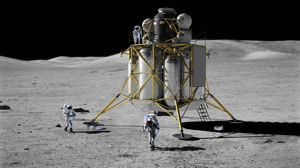
An image of potential space travel under the Constellation Program. (Image Courtesy of NASA)
YOUNG: From the Jennifer and Ted Stanley Studios in Somerville, Massachusetts – this is Living on Earth. I’m Jeff Young. Houston - you may have a problem. President Obama’s NASA budget would scrap the space agency’s Constellation program. That hundred billion dollar project to return people to the moon by 2020 was behind schedule and over budget. In announcing Constellation’s demise, Presidential Science Advisor John Holdren said the administration still has big plans for NASA:
HOLDREN: It is not a retreat from U.S. leadership in human space flight as some are asserting but rather an exciting and promising path forward.
YOUNG: In fact, the president would boost NASA’s budget by six billion dollars over the next five years. But NASA would rely on private companies to put people into space. Keith Cowing is a former NASA engineer who now edits NASA watch dot com. Mr. Cowing – is this a giant leap for commercialization of space travel?
COWING: Well, I’ve been calling it a paradigm shift. Yes, it is quite a change in the way that NASA wants to do business from the way its been doing it for the past 30, 40, 50 years. Imagine it’s 1967 and NASA just decided to cancel Apollo. That’s about where it is except they’re saying, wait we’re canceling the program, but not the intent. I think this is a nuance that’s lost on some people. They say, “Oh we’re not going to do human space exploration anymore.” Not true! Every indication I get is, they’re not saying, “Well, let’s sell the astronaut’s spacesuits, we don’t need them anymore.” That’s not the case. They’re just going to do it differently.

An image of potential space travel under the Constellation Program. (Image Courtesy of NASA)
YOUNG: Is this akin to the way that we launched commercial air travel?
COWING: Oh, it is, it’s exactly akin to that. You found that back in the olden days in the teens and the 20’s that it was carrying airmail that actually subsidized flights that people would say, I can take the mail, but I can take a paying passenger. If you look at the way that Pan Am pioneered service in the Pacific – they started taking flying boats and hopping from island to island to island and once the richer patrons had sort of made a market success for that, other companies came along and said, “Hey, how about if you don’t have champagne and we crowd you in more closely in the planes?” And slowly competition emerged. But it has to start somewhere, somebody has to prime the pump, often times it is the government or the richer part of the private sector. Sometimes both.
YOUNG: So, is this going to pave the way for making space travel A) a commercial venture primarily, and B) more common?
COWING: Well, it already is commercial, the funny thing is that the Russians have been taking paying passengers for the better part of a decade now. And I always find great humor in that you have a country who’s got a capitalist economy that’s barely been a decade and a half old and they came out of Communism, and yet they’re teaching us how to commercialize space. And we’ve got an economy that’s two and a half centuries old based on the capitalistic way of doing things. So, this isn’t new, it’s just it’s new to America.
YOUNG: So, private companies in all likelihood giving us the means to get there. But, where’s the ‘there’? What’s the destination?
COWING: It’s not like it’s a mystery, it’s quite clear that they – the moon is not out like a lot of people say, it’s just that we might not be building giant moon bases there. But, it may be that we go to the moon with Europe or Japan. Mars is an obvious destination, as are near-Earth objects, asteroids and other things. So, it’s not like NASA doesn’t know where it wants to go, and hasn’t actually put some work into this, it’s just that you haven’t seen the press release saying, we’re going to go here on this date.

An artist’s depiction of NASA’s plans for the Constellation Program – a lunar lander called Altair putting people on the moon. (Image Courtesy of NASA)
YOUNG: There were some tantalizing hints about big game-changing, breakthrough technology that they’re going to be looking into here. I didn’t hear a lot of detail on that though – what are they talking about in terms of new technology that’s really going to change the way we get to and through space?
COWING: Well, right now, we use rockets, but there are some new technologies that have been tried out. One is ion thrusters where you in essence send out particles at very high speed, using an electrical system and because they’re leaving at such high speed, they’re like rockets in that you’re throwing something out: f = ma, and all that. But the thing is they’re very efficient and they can build up very high thrust, and they can be electrically powered. So, these ion propulsions is one thing they’re looking at.
Another thing they’re looking at is plasma propulsion and there’s this concept called vassimere or vassamere, depending who you’re talking to. And the beauty of this is it’s electrically powered and if it works, and it seems to work, much more efficient than taking big tanks full of chemicals up there and then igniting them. That’s what’s changing.
YOUNG: Is it a possibility that these new technologies might end up greening aviation, in general?
COWING: Oh, absolutely. As a matter of fact, if you look at budget documents, you see that they say aeronautics are green aviation. And one of the things that’s very popular these days is looking at biofuels and green aviation fuels. I think you’ll see that, and I think you’ll see that in a context of a bigger picture.
How do you integrate green aviation mindset into the grander scheme of how the aeronautics and aviation and air travel system works in the United States? It’s a daunting task.
YOUNG: You know, hidden among the news about the cuts to these programs there’s also a boost to the overall budget here, a pretty big one, including a sizable increase in earth science programs. Tell me about that.
COWING: Well, it’s not a surprise. I mean, the Obama administration talked very much about the climate and the previous administration pooh-poohed the notion of global change as being something that we needed to be really concerned about. And NASA’s earth science budget suffered as a result, so that’s not a surprise to anybody that this is being brought back.
So, yeah, our earth observation from space – big shot in the arm. The question is the money being taken for that, where is it coming from, and the space science aspect of NASA is not getting a big increase pretty much as a result.
YOUNG: Well, it sounds like you, a former NASA guy, still closely following NASA think that – you’re pretty bullish on this idea, you think this is a good direction?
COWING: Yeah, but, you know, step one, step two – there’s a lot of eggshells that have been stomped on here, a lot of sandboxes that have been upset to use the NASA parlance, and there’s a lot of people who will beg to differ that this is the right thing to do. And I don’t really think you’re going to see a clear answer to all this for many months.
YOUNG: Keith Cowing from NASA Watch dot come telling us about big changes at NASA – Thanks very much!
COWING: My pleasure.
Related link:
NASA Watch
A New Fission Provision
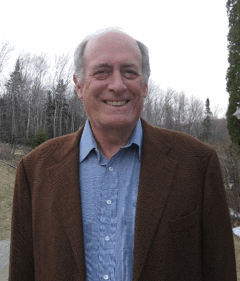
Peter Bradford, is a former member of the Nuclear Regulatory Commission and teaches at the Vermont Law School.
YOUNG: Now, the President’s budget also aims to change energy: it would do away with fossil fuel subsidies and put more into clean energy. But the part that’s really generating buzz has to do with nuclear energy. President Obama’s budget calls for 54 billion dollars in federal loan guarantees, tripling the amount companies could tap into to help build new reactors.
Peter Bradford is here to help us put that in perspective. Mr. Bradford does not oppose nuclear power, in fact, as a former member of the Nuclear Regulatory Commission, he put his name on the licenses for several reactors. But he does oppose the president’s decision.
BRADFORD: Well the nuclear industry at the moment is unable to finance construction of any new nuclear plants. Early in the Bush administration, Congress passed legislation providing for tax credits to encourage new nuclear plants, and also several years ago provided 18 billion dollars in loan guarantee authority. And for the nuclear industry, things just haven’t worked out as intended. A number of companies came forward with applications for a total of 31 new plants. They’ve all run into trouble of one kind or another. There have been cost overruns, cancellations, suspensions, delays, and in two cases in Florida and in Texas there have been scandals, as well.
So the nuclear renaissance has not been a great success to date, and in that context it seems a little eccentric to be tripling down and say, okay, if 18 billion in loan guarantees didn’t do it, maybe 54 will.
YOUNG: So, you don’t think that the 54 billion in loan guarantees would be enough to shake loose the private investment from Wall Street?
BRADFORD: Well, no. I mean loan guarantees aren’t a certificate of fiscal health anymore than blood transfusions are a certificate of physical health. You resort to loan guarantees because the enterprise isn’t healthy, and the problem with that scenario for nuclear power is that it’s in theory a mature industry; it’s been with us for 50 years and even though there are some new designs at this point, it really shouldn’t been needing this kind of help.
The only thing that’s going to persuade Wall Street or private investors would be to have those plants built at competitive prices and to have them run well. And that’s a scenario that will take quite a few years to play out.
YOUNG: And what do you make of nuclear power as a climate change solution? That’s pretty much how this is being marketed, that this is carbon-free, or at least low-carbon source of base load power, therefore, it’s our path to cutting our carbon emissions.

Peter Bradford, is a former member of the Nuclear Regulatory Commission and teaches at the Vermont Law School.
BRADFORD: Nuclear power is a low-carbon source, even when you take the full nuclear fuel cycle into account, but it’s a very expensive low-carbon source, at least in today’s energy markets it’s too expensive to be an effective climate solution.
It’s as if a homeowner with a leaky roof to their house decided that the solution was to put in a second furnace, rather than fix the roof. It takes too much of the money that societies around the world are going to be able to spend fighting climate change and devotes it to a source that just can’t respond quickly enough.
But it’s even more problematic than that. If you look back at what happened, say, in New England with the Seabrook nuclear plant, as companies try to build these very expensive units and got into trouble they cut way back on their efforts at energy efficiency at other sources--such as even their own natural gas divisions in order to both husband the resources to finish the plants and in order to make sure that demand was there for the kilowatt hours at the end of the day. So, we know that nuclear power has that ability to displace interests in other resources when it gets into trouble.
YOUNG: How does this level of support for nuclear energy compare to the support that we see for other forms of energy – let’s say new wind or new solar?
BRADFORD: New wind and new nuclear are both eligible for production tax credits, but new nuclear has trouble using them because with a production tax credit you have to produce something and the wind people have been able to do that. But, with new nuclear the concern is that the plants may not come online.
YOUNG: I take it from your comments so far you don’t think it’s a good idea in the short view. But is this a good approach long-term to looking to say a new generation of reactors many decades hence?
BRADFORD: Well, what’s a defensible approach is perhaps to back a limited number of plants in return for getting cap and trade, and then see how those plants perform. What does make sense would be to put a cap and trade bill in place, use the 18 point five or 54 billion, whatever it turns out to be, to find out what new nuclear plants can do. But, meanwhile, the cap and trade regime will establish a new energy market place, in which we’ll find out what it really costs to clean up the atmosphere of greenhouse gases. And we’ll see whether nuclear really has a place.
YOUNG: Peter Bradford’s a former member of the Nuclear Regulatory Commission, now a teacher at the Vermont Law School -- thanks very much.
BRADFORD: It’s been a pleasure.
Related links:
- To hear more of our interview with Peter Bradford, click here.
- The Nuclear Regulatory Commission’s website
[MUSIC: Timewarp Inc “FunkE” from Dub My Funky Groove (Timewarp Music 2005)]
YOUNG: Just ahead – Trying to chart the right course for offshore wind power – Keep listening to Living on Earth!
The Battle for Cape Wind

(Photo: Jeff Young)
YOUNG: It’s Living on Earth, I’m Jeff Young. For wind energy enthusiasts, Cape Wind in Massachusetts is probably the most famous and frustrating proposal in the U.S. What could be the country’s first offshore wind farm has been without a permit for construction for nine years—blocked by those who want to protect the ocean view off Cape Cod. U.S. Interior Department Secretary Ken Salazar wants an end to the delay. He recently boarded a boat to go see the Cape Wind site and hear from both supporters and opponents.
SALAZAR: We have an imperative to harness the power of the wind. But as I’ve always said, it’s important to do wind energy in the right places and that is the critical question we are addressing here on Nantucket Sound, is this the right place for wind energy or is it not?
YOUNG: For years, Cape Wind’s opposition came from the Cape’s most famous part time residents—the Kennedy clan. But the latest and possibly toughest hurdle comes from the first to inhabit this area: the Native Americans whose ancestors settled Cape Cod and the islands thousands of years ago.
[SOUNDS ON WINDY BEACH, WALKING]
YOUNG: The wind puts on a show the day I visit Martha’s Vineyard, with gusts whipping the Sound’s waters into whitecaps. But my guide, Bettina Washington, is not too bothered.
WASHINGTON: It’s a little windy today, a little cold. But beautiful and sunny, so that’s good.
YOUNG: The sun is Washington’s concern here, specifically the rising sun. Washington is Historic Preservation Officer for the Wampanoag Aquinnah Tribe, based on the island. If Cape Wind’s 130 turbines go up as planned about nine miles from this beach, it would affect the view of the rising sun. Washington explains that greeting the dawn is at the core of Wampanoag culture.
WASHINGTON: Our name is the Wampanoag, which means people of the first light, or the dawn. It’s our identity. It gives us a sense of place, where we belong; it’s how other tribes relate to us. So this place is very special to us.

Bettina Washington. (Photo: Jeff Young)
YOUNG: We huddle on the leeward side of a wall and Washington tells me some stories from the tribe’s oral history. Most feature Moshup, a giant who caught whales to feed the people. In another story, it’s Moshup who causes the waters to rise and fill Nantucket Sound.
WASHINGTON: When Moshup brought us here he dragged his foot and created the Sound. That’s how the waters came in.
YOUNG: The legend has echoes in archeological records that show the Wampanoag have been here so long that land they once lived on is now submerged. Horseshoe Shoal, now under 50 feet of water, is one of the likely spots of early Wampanoag activity—it’s also where Cape Wind’s towers would be anchored.
WASHINGTON: Our oral history says we walked across here, so we would have been traveling across living here, making our livelihoods here, and also burying our people here. When you’re talking in excess of ten thousand years, you know, that’s a long time.
YOUNG: So what would it mean if you came to this beach and along with the rising sun you saw wind turbines out there?
WASHINGTON: It would definitely be a disturbance because if that is built our children and those that are yet to come will not be able to do this. It’s like a sense of – a type of extinction of a cultural practice. [Sighs]
YOUNG: About four years ago the Wampanoag of Aquinnah and nearby Mashpee argued that the Sound itself has cultural significance to the tribes. In an unusual decision this year the National Park Service’s Keeper of the National Register of Historic Places agreed.
The keeper made 560 square miles of Nantucket Sound eligible for listing in the National Register—a first for an open body of water. Cape Wind president Jim Gordon says that decision should not be allowed to further delay his project, which he started developing back in 2000.

The sun rising over Martha’s Vineyard. The Wanpanoag, or “the people of the first light,” say they don’t want wind turbines to come between their daily dawn greetings. (Photo: Bettina Washington)
GORDON: We thought that the development would take three or four years. This has been a tough, tough slog.
YOUNG: Gordon also tells me a story about rising waters, and avoiding them. He says polls show 80 percent of Massachusetts’ residents support the project, largely because they want clean energy to combat the threats of climate change.
GORDON: I’m talking about our beaches eroding away. I’m talking about more frequent and increased hurricanes and storms, warming of the ocean, ocean acidification. Cape Wind really is about preserving and enhancing the environment of Cape Cod and providing a healthier environment for the citizens that live in that fragile coastal community.
YOUNG: If Cape Wind were operating today, what would it mean in terms of greenhouse gas emissions offset?
GORDON: Well you’re looking at my iPhone and that’s dialed right into our solar powered meteorological station. Right now, Cape Wind would be producing 422 megawatts of clean renewable power. That would be enough to power almost 400 thousand homes. We would be offsetting almost one million tons of greenhouse gases annually.
YOUNG: Cape Wind would provide about two percent of the state’s electricity. But Ian Bowles says it represents more than that. Bowles is Secretary of Energy and Environmental Affairs for Massachusetts. He hopes Cape Wind would jumpstart other wind projects that would eventually meet a quarter of the state’s power needs.
BOWLES: Well, you know, it has a symbolic importance at the national level; it’s probably the highest profile wind energy project in the world at this stage, and something being closely followed. And I think if many observers view that we can’t move forward with projects like this we have problems in terms of making the tradeoffs and the choices we need to make for renewable power.
YOUNG: Even with its controversy, Cape Wind has pushed along federal and state rules and planning for offshore wind. Laurie Jodziewicz of the American Wind Energy Association says that means other projects should have an easier path, regardless of Cape Wind’s fate.
JODZIEWICZ: I would say if it does not happen there is tremendous momentum behind all of these other offshore projects. And so while we’d all like to see the Cape Wind Project be successful it certainly is not a make or break issue or make or break project for the offshore wind industry as a whole.
YOUNG: Jodziewicz says projects in Delaware, New Jersey and Rhode Island look strong. Massachusetts will know soon if Cape Wind could still be the first in the water.
Interior Secretary Salazar has set a deadline of March first for the parties to reach a consensus agreement. But after his trip to Nantucket Sound, the secretary didn’t sound especially hopeful.
SALAZAR: This project underway for a very long time, and there are passionate feelings on both sides. And so I’m not holding my breath for a consensus.
YOUNG: If there’s no agreement Salazar says he will make a decision on the permit himself by April.
Related links:
- Wampanoag Tribe Home Page
- Cape Wind Home Page
- National Park Service- Nantucket Sound
[MUSIC: Vince Guaraldi “Cast Your Fate To The Wind” from Manha De Carnival” (Fantasy Records 1961)]
Coal Ash Controversy
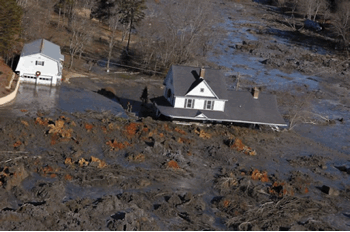
The collapse of a wall on a retention pond at the Kingston power plant in Tennessee caused more than a billion gallons of coal combustion waste to flood 400 acres around the plant. Up to 10 homes were flooded, some lifted completely of their foundations. (Photo: The Knoxville News Sentinel © 2008)
YOUNG: The U.S. Environmental Protection Agency is telling electric utility companies to dispose of coal ash more safely. Most of the waste from burning coal in power plants is dumped in landfills or behind the dams of slurry ponds, called impoundments, with little government oversight.
About a year ago one of those dams in Tennessee burst, spilling a billion gallons of waste into the Emory River. At the time, local resident Sarah McCoin described the sludge that inundated dozens of homes close to the power plant.
MCCOIN: Charcoal-gray, gooey, nasty, gummy, it looks like the inside of a volcano that has just been active, and it goes as far as the eye can see. It's a very sick feeling; it certainly brings a tear to your eye. And then obviously I’m worried about my health - my health, my family's health, the health of my friends and neighbors.
YOUNG: In the wake of the spill EPA promised action. Well, this month EPA told 22 power plants to strengthen their ash impoundments to avoid further spills. But EPA still has to decide how to regulate the ash itself.
The agency’s self imposed deadline for new rules passed a month ago and White House officials are still debating. Coal ash often contains arsenic, lead, mercury and other toxics. That’s why many scientists urge EPA to declare coal ash a hazardous material. Some industry groups say that could make it harder to recycle the ash. We’ll hear from both, starting with Thomas Adams. He’s Executive Director of the American Coal Ash Association, whose members turn ash into useful products.
ADAMS: Well, probably the marquee product would be fly ash, which is used in concrete as a partial supplement replacement for Portland cement, gives us a dramatic increase in durability of concrete. Another one that is all around us is a material called boiler slag, which is used as the grit in shingles for roofing shingles – approximately 80 percent of the residential roofs in this country use shingles which incorporate boiler slag.
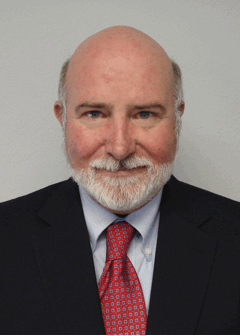
Thomas Adams is Executive Director of The American Coal Ash Association. (Courtesy of the American Coal Ash Association)
YOUNG: The production of cement is pretty energy intensive, and they produce a lot of CO2 emissions. If you’re stretching out the cement, improving it with this ash, are you saving energy and reducing emissions, as well?
ADAMS: Absolutely. If you look at the use of fly ash as a partial replacement for Portland cement, you’re looking at a ratio of about nine tenths of a ton of CO2 avoidance for every ton of cement reduction that you can identify.
YOUNG: And how much coal ash gets used this way?
ADAMS: Annually, in our most recent survey, we had 136 million tons of coal ash produced, of which 44 percent was recycled into a variety of different applications.
YOUNG: So that’s 44 percent of the total coal ash produced in the country?
ADAMS: Yes. That’s by electric-fired coal utilities. There are other ash producers, which come from industrial boilers, which include private industry that has their own boiler for utility purposes on their own sites, and universities and other institutions like that. That’s not included in that 136 million tons.
YOUNG: So, now, what is your concern about the pending regulatory decision on how to handle coal ash?
ADAMS: We’re focusing on trying to keep this success story of recycling this material moving forward and not have it go backwards by any stigmatization of this material as being hazardous. Certainly, when we have a choice of selecting products as consumers, if we take a look at a hazardous product as identified by some label by the federal government, versus a non-hazardous label, we certainly want to select a not hazardous label as consumers would.
And we feel that if we have a hazardous determination of any kind come out of EPA, that that stigma will be attached to these products and cause the recycling effort to retreat, and in some cases almost stop, and we’ve seen market impact already that some people are moving in that direction.
YOUNG: However, I mean, don’t we recycle and reuse a lot of things that are rightly and officially considered toxic? I mean, I just look at my car and I think about the reuse of old batteries, recycling/reuse of motor oil – these are things that contain substances that are hazardous if improperly disposed of, but that doesn’t keep us from having a robust system for reuse and recycling.
ADAMS: Absolutely, and that’s – those are success stories by themselves. But if you look the used oil example, the used oil is reprocessed and then incorporated again into another finished product, which is primarily used in an industrial setting. Whereas our product is not reprocessed and is put into a commercial/residential setting by and large, and the public is very, very close to that.
YOUNG: But aren’t you essentially telling people to ignore the fact here? I mean ash is toxic.
ADAMS: If it’s mismanaged it can have some effect on health and environment. The key point to remember is these materials are harmful when there’s an opportunity for ingestion. If we’re putting them into an environment, which does not allow ingestion or has a very low probability of ingestion then you can safely assume that we’re not really dealing with a dangerous situation.
YOUNG: Thomas Adams, executive director of the American Coal Ash Association, thanks.
ADAMS: Thank you for having me.

The collapse of a wall on a retention pond at the Kingston power plant in Tennessee caused more than a billion gallons of coal combustion waste to flood 400 acres around the plant. Up to 10 homes were flooded, some lifted completely of their foundations. (Photo: The Knoxville News Sentinel © 2008)
YOUNG: Well, Mr. Adams is at odds with some scientists who have studied coal ash disposal sites for decades. Wake Forest University research biology professor Dennis Lemly says recycling ash is a fine idea, but it’s not really the point here. Lemly says the pending decision on how to regulate coal ash should be driven by data. He and his colleagues wrote to the White House to set the record straight about coal ash toxicity.
LEMLY: With respect to the health of fish and wildlife there's no question that coal combustion waste is a highly hazardous substance. The Gibson coal plant in Indiana polluted an entire wildlife refuge. The U.S. Fish and Wildlife Service is now involved in a major clean up of that site. The Savannah River site in South Carolina, it contaminated wetlands and deformed amphibians for miles downstream. The coal strip plant in Montana and many other facilities have contaminated offsite ground water in addition to surface water. And experience shows that really the only way to effectively control this material is to place it with a hazardous waste designation.
YOUNG: What are the implications for human health?
LEMLY: Well, in terms of the leaching of these materials into groundwater and contamination of public water supplies there are several well-known cases of that that have taken place, where the electric utilities have had to bring in bottled water and provide alternative water supplies for local residents. So, we’re seeing that there are very clear case examples of situations where human health has been directly impacted by the disposal of these wastes.
YOUNG: Give us a sense of the scale of the waste that we’re talking about?
LEMLY: Well, it is a national issue. For example, across the country there are literally hundreds of sites that are at least active at this point. And there’s several inactive sites, as well. So, if you look at the total number of coal combustion disposal sites across the country, it’s well over 2,000.
YOUNG: So this stuff is highly hazardous in your opinion, there are these sites all over the country - surely we’re regulating this stuff, right?
LEMLY: The current regulations are kind of a patchwork. They’re left primarily up to the states and the level of control for these materials and the way they’re disposed is highly variable from state to state. For example, there are a couple states – for example California--that require more stringent regulations, many other states have very lax rules in terms of how materials can be disposed and what requirements there are for liners and leachate collection, and that kind of thing. So it is really a patchwork and that’s one reason why there’s a need for federal oversight because the state regulations are so variable and so inadequate in many cases.

Dr. A. Dennis Lemly is Research Professor of Biology at Wake Forest University. (Courtesy of Wake Forest University)
YOUNG: And the big argument here though, let’s face it, is cost. Isn’t it going to end up simply costing too much to do the kind of protective measures you’re recommending here?
LEMLY: Well, in fact, if you look at the cost, I would maintain that the cost of the un-regulation that exists now is out of control and even more expensive than the cost of a hazardous waste designation and disposal of the material under that type of requirement.
For example, just a year ago the ash spill at the TBA Kingston plant – clean up costs for that one episode alone is going to be over a billion dollars. And we can look at other locations where clean up costs are in the millions for every single case of contamination. So if you look at it on a national scale over a period of time, the total cost of no action and the clean up associated with that is going to be much greater than the cost of a hazardous waste designation, and proper management and prevention of future contamination problems and clean up costs.
YOUNG: Do you see this as a test of the Obama administration’s commitment to science?
LEMLY: Oh, I think it is. I think it’s very clearly going to be perhaps a test case in terms of using science to guide policy. Because the science is there, it’s very clear, it’s not ambiguous, it’s been there starting 30 years ago – we have compiled a tremendous case-by-case information base and database on which to base the decision, the policy decision.
YOUNG: Wake Forest University biology professor, Dennis Lemly, thanks very much.
LEMLY: You’re welcome and thank you very much for having me.
YOUNG: And you can learn more about coal ash and read EPA’s assessment of where the most potentially hazardous impoundments are at our website l-o-e dot org.
Related links:
- Tennessee Valley Authority on the Kingston Plant
- American Coal Ash Association
- Dr. Lemly’s Letter to EPA and OMB
[MUSIC: Tom Verlaine “Metoer Beach” from Around (Thrill records 2005)]
YOUNG: Coming up: the scientific approach to scaring a bear.
MAZUR: Everyone has a story of a bear getting their food, so if you imagine a million people all letting a bear get into their food once, you know, you’ve got a problem.
YOUNG: A biologist on the best way to avoid those problems and what I did wrong in my bear encounter. That’s just ahead on Living on Earth.
ANNOUNCER: Support for the environmental health desk at Living on Earth comes from The Cedar Tree Foundation. Support also comes from the Richard and Rhoda Goldman Fund for coverage of population and the environment. And from Gilman Ordway for coverage of environmental change. This is Living on Earth on PRI – Public Radio International.
[MUSIC: Brad Mehldau: “Paranoid Android” from Largo (Warner Bros 2002)]
Listener Letters
YOUNG: It’s Living on Earth, I’m Jeff Young.
[TYPEWRITER SOUNDS, LETTERS THEME]
YOUNG: Time now for comments, from you. Our coverage of the climate and energy proposals in the State of the Union speech generated both heat and light. Some listeners support the President’s call for more nuclear power and offshore drilling – but many more say Friends of the Earth got it right calling the president’s speech “a kick in the gut”.
“Yes I do feel that way,” writes Laurie Larson, who hears our podcast in Trenton, NJ – “Nuclear energy is NOT clean” she writes, “until there is a way to safely deal with the waste. And it is vastly expensive. Resources should instead go to R&D for really clean energy.”
Kel Pickens of Stilwater Oklahoma hears us on KOSU. He echoes that call for investment in renewable energy.
PICKENS: When will Obama learn to just do it? He may be surprised how many of us are behind him. But, by supporting and backing nukes, he may be responsible for setting off new waves of anti-nuclear protests and legal actions that will make the last resistance to nukes look like a warm-up.
YOUNG: Our interview with Mark Levy of the Haiti Regeneration Initiative, in the wake of the earthquake sparked many appreciative comments, including one from Collene Mildes who hears us on WNJT near Princeton. She writes: “A sustainable environment is essential for Haiti… I (and I am sure many others) would be willing to support vegetation-restoration and reforestation projects for the Haitian people.”
WBEZ Chicago listener Statia Orange took issue with our interview though – she thought we glossed over the responsibility of Haiti’s colonial rulers for the environmental degradation the people currently face.
ORANGE: No comments were made about how they were forced by the French to pay for the robbing of the wood the trees for furniture and other resources. They did not voluntarily get rid of their resources they were robbed of it. Haiti is in this situation because of its treatment by western countries.
YOUNG: Well, whether you want to give us a sweet pat on the back – or a swift kick somewhere else – we’re always glad to hear from you – our listener line is 800-218-99-88 – that’s 800-218 -9-9-8-8 – Or email us at comments at l-o-e dot org.
[LETTERS THEME]
How to Scare a Bear

YOUNG: The giant trees of Sequoia National Park in California attract nearly a million visitors each year. All those people and their picnic baskets also attract a lot of black bears. Last year alone, the park reported over a hundred human-bear conflicts. So park officials wanted to know how to reduce those risky wildlife encounters.
Bear biologist Rachel Mazur has been working on the problem – and published a study on how best to scare a bear.
MAZUR: Basically, I've been working at the Sequoia and Kings Canyon National Parks where we have massive numbers of human-black bear conflicts, as they do in many other parts of the country and other parts of the world, and we're looking for solutions and using hazing, or aversive conditioning, on these bears was something we'd been doing but we didn't know how well it was working.
YOUNG: Aversive conditioning – what are we talking about here? Trying to scare them?
MAZUR: Yes, in a way. I mean, basically what you’re doing is trying to retrain behavior. And so you’re trying to make them associate something negative with what they thought was something positive. So, where they would go into a campground or go into a car or something to receive human food, we want them to think of that as something they don’t want to do.
YOUNG: So what kind of things are you doing here – what are we talking about actually?
MAZUR: The most common one is really just yelling at bears: get out of here bear! Waving your arms, looking big.
YOUNG: [LAUGHS] And how does that work?
MAZUR: [LAUGHS] It works pretty well on naïve bears, or – we call them naïve bears, but bears that aren’t very food-conditioned, used to human food, or very habituated. But then there’s other methods that are much more intense using pepper spray, using paintball guns, using rubber slugs, which are basically the rubber bullets you think go with riot teams or something like that.
YOUNG: And how do those techniques work?
MAZUR: They’re mixed. So on the naïve bears, they work great; they work great in saying, don’t come into these areas, this is not a good place for you, you want to go back and eat acorns and eat berries and that sort of thing. With bears that have already received a lot of human food and are used to entering human areas, they’re not very successful.
They will, however, keep bears away from humans, increase their fear of humans, and make them change their techniques for getting human food. So, instead of coming in boldly in the middle of the day and walking up to a picnic table, they might sneak in at night and grab a cooler that’s hidden behind a tree.

YOUNG: So at least you’re reducing the chance of something really bad happening, but they’re still going to raid the trash can occasionally, that sort of thing, but –
MAZUR: Exactly. In terms of, you know, re-wilding them or however you want to phrase it, the success rate’s pretty low.
YOUNG: You know, I find this very interesting in part because a couple summers ago I had a bear encounter of my own, and I tried to scare that bear, or so I thought. And I got to tell you, the bear was not impressed, and he did what I think you call a bluff charge, and –
MAZUR: Okay.
YOUNG: I ran away, I may have screamed like a little girl, but lets just say I did not succeed in scaring the bear. What did I do wrong, and what should I have done in that situation?
MAZUR: [LAUGHS] Well, first of all, you never run from a bear because –
YOUNG: There’s strike one against me: I should not have run screaming like a little girl – probably not good, either. [LAUGHS]
MAZUR: As a side note, the gender and size have nothing to do with it, but what people do a lot is a bear will come into their campground, and they’ll say, “Get out of here bear!” And they get all excited and go running after the bear and they leave their food on the picnic table, so we say it’s great to yell, it’s great to try to make them afraid of you, but put your food away! That’s the most important thing.
YOUNG: Well, you know, it sounds to me like what you’re really after is not so much changing bear behavior, but changing people behavior.
MAZUR: Exactly. It’s way easier to just put your food away to begin with than creating this problem and trying to fix it. And so, if you’re in one of these parks where you have a million visitors in a place like Yosemite, several million visitors coming in a year; you have a lot of people to train.
Sometimes when you talk to people, everyone has a story of a bear getting their food. So, if you imagine a million people all letting a bear get at their food once. You’ve got a problem. And so there’s constant education of people: holding your food, how to be around bears, giving them space. We don’t want people near bears; they should be 50 meters away from bears. People like to say, “Oh I could get really close and get a good photograph.” Well, instead get a telephoto lens. Stay away from them. What you’re doing, the closer you’re getting to them is you’re habituating them or muting their response to humans.
YOUNG: I guess that’s something that a lot of visitors to parks need to keep in mind is it may seem harmless to throw a marshmallow to a bear, and oh isn’t it cute? But, in the long-term you may doom that animal because if it becomes a regular there park managers may have no choice but to kill the animal, right?
MAZUR: That’s true, and I think a lot of times the people who first gave food to the bear are long gone by the time the bear’s behavior is so, I guess you’d say, risky that you need to take its life. And so near the end of a bear’s life, the people that have left their food out, they might have just left out a candy wrapper or something small. And so they feel horribly guilty, but it was really the person three months earlier that had left a cooler unattended while they went to the bathroom that really caused the problem.
YOUNG: Did you ever feel like the ranger in a Yogi Bear cartoon during all this?
[YOGI BEAR RANGER: “OOOH, THAT YOGI!”]
MAZUR: [LAUGHS] You often feel, yeah, they would sneak, you’d be looking for them, we’d spotlight around – where are the bears, looking around. And they’d be hiding behind the dumpster, but their butt would be sticking out one end, so you could see –
[YOUNG LAUGHS]
[YOGI BEAR CLIP]
YOUNG: Bear biologist Rachel Mazur telling us about the best ways to scare bears. Thanks very much.
MAZUR: Thank you.
Related link:
Check out Rachel Mazur’s book, “If You Were a Bear”
[MUSIC: Garage A Trois “Bear No Hair” from Outre Mer (Spire Media Artists 2005)]
Cool Fix for a Hot Planet
YOUNG: Just ahead – how whistling while you work can turn you into an expert birder – but first this Cool Fix For a Hot Planet from Emily Guerin.
[BALLPARK SOUNDS]
GUERIN: On Opening Day in April, the Minnesota Twins are hoping to hit a grand slam in sustainable design with their new stadium, Target Field. The stadium underwent a two and a half million dollar redesign to make it eligible for LEED certification, the U.S. Green Building Council’s rating of a building’s environmental impact.
[COOLFIX THEME]
Target Field has a number of environmentally friendly features already: it was built on an existing site, is close to public transportation, and was constructed with local building materials.
But to really hit the ball out of the park, the Twins are installing a gigantic rainwater collection system beneath the field. Rain that falls on the seven-acre park will drain into a school-bus-sized underground tank designed by a Minneapolis company called Pentair.
The water will be filtered and re-used to irrigate the field and wash the lower decks of the stadium. The Twins hope this system will cut their water needs in half—reducing consumption by two million gallons per year. Pentair will also provide water filters in offices and team areas to promote tap water and reduce the use of plastic water bottles.
If the Green Building Council approves the park, the Twins will become the second major league baseball team with a LEED-certified stadium, but the only one with a winning record. The other green park belongs to the Washington Nationals, who finished the 2009 season with the worst record in baseball.
That’s this week’s Cool Fix for a Hot Planet. I’m Emily Guerin.
[COOLFIX THEME]
YOUNG: And if you have a Cool Fix for a Hot Planet, we'd like to know it. If we use your idea on the air, we'll send you a sleek electric blue Living on Earth tire gauge. Keeping your tires properly inflated can save hundreds of dollars a year in fuel. Email us at coolfix—that's one word—at l-o-e dot org. That's coolfix at l-o-e dot org.
Bird Whistler
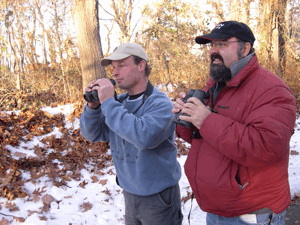
Patrick Dugan and his friend Frank Gallow go birding. (Photo: Laurie Sanders)
YOUNG: Bird watching as a hobby dates back to the late 1800s, when studying birds for their looks and behavior became more fashionable than hunting them for food. These days, advances in technology have revolutionized birding – from high tech binoculars to smart phone apps that can play recordings of bird songs to try to lure them in. But some birders have their own special ways to attract our feathered friends. Producer and naturalist Laurie Sanders has this profile.
[TREE SPARROW SOUNDS]
SANDERS: Hear those tree sparrows? Well, actually those aren’t real tree sparrows. It’s Patrick Dugan.
DUGAN: There’s one, two, three, four, five, six of them – six of them came in.
GALLOW: It works, he did tree sparrow and six of them popped up out of the bush and came over to us. [LAUGHS] It’s like having a tape recorder, just walk along and push play.
SANDERS: On this windy day, Patrick Dugan and his friend, Frank Gallow are birding along the edge of a small patch of woods at Lighthouse Point in New Haven, CT. Patrick Dugan is a phenomenon. He has perfect pitch, and during his 20 years of birding, he’s memorized more than 1,000 bird songs and can now imitate well over 100 songs and call notes.
He and Gallow routinely lead birding trips together. And over the years, they’ve participated in dozens of bird counts—including the world series of birding in New Jersey, where the goal is to find as many species as possible in a 24-hour period. At these events, Gallow says Dugan’s uncanny skills are a huge advantage.
GALLOW: The more tuned your ear is, and Pat has an amazing ear, the more species you can count. So, you have to practice and practice and practice. His ability to reproduce chirp notes, both as a reminder to himself, but also on some occasions he actually can get the birds to call back to him. So he’ll chirp into a bush where we think we saw a white crowned sparrow, and it’ll pop up and chirp back at him.
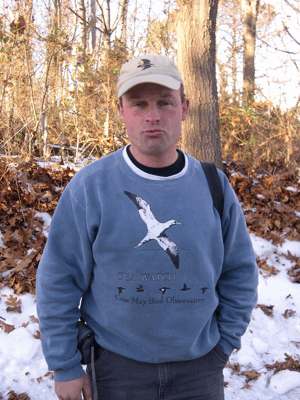
Bird whistling expert Patrick Dugan. (Photo: Laurie Sanders)
[BIRD CHIRPS]
SANDERS: Dugan’s interest in birds began in his early 20’s when his brother took him bird watching. After seeing a scarlet tanager, he was hooked. What appealed to him was the challenge of finding and identifying birds, especially the trickier groups like gulls and shorebirds, sparrows and flycatchers (species that visually resemble each other, but can often be more easily separated by their songs and call notes).
And so, Dugan—who was a precocious whistler, beginning when he was just a toddler—began trying to imitate the sounds he was hearing.
DUGAN: Well start basically by whistling.
[DUGAN WHISTLES]
DUGAN: Start with that. Then set releasing and pressuring the lips.
[HIGHER PITCH WHISTLE]
DUGAN: That’s all different movements of the lips.
[CONTINUES WHISTLE]

Patrick Dugan and his friend Frank Gallow go birding. (Photo: Laurie Sanders)
SANDERS: And then he says you start moving your tongue back and forth and working on controlling the air pressure as it moves between your teeth.
DUGAN: It all depends on the tones that I do it in, the speed that I do it in.
[DUGAN QUICKLY WHISTLES DIFFERENT TONES]
DUGAN: Or slower.
[DUGAN WHISTLES A SLOWER, DEEPER WHISTLE]
DUGAN: Or, it depends on the birds. You know, buzzy like prairie warbler
[DUGAN WHISTLES ABUZZING WHISTLE]
DUGAN: Or black throated blue
[DUGAN WHISTLES SHORT WHISTLE]
DUGAN: Or black throated green.
[DUGAN WHISTLES A MANY-TONED WHISTLE]
SANDERS: For much of his adult life, Dugan was able to practice his whistling at his job. For years, he was a picture framer, working alone in the shop’s basement, where he listened to recorded bird songs and practiced imitating them. And he practiced and practiced.
The most complex song he whistles is that of the winter wren, which took him over six months to perfect.
[DUGAN WHISTLES THE WINTER WREN CHIP]
[SANDERS LAUGHS]
DUGAN: It makes me smile every time.
SANDERS: A few years ago, Dugan’s remarkable ability came to the attention of Woody Allen, who asked him to audition for the talent show scene in the movie “Sweet and Low Down,” featuring Sean Penn.
DUGAN: I went in, they filmed me, Woody Allen said, “Here stand here, do three birdcalls, do the name then the calls, when I say action go.” So I did. I did scarlet tanager, white-throated sparrow and barred owl. And I was there for about 13 hours, or so, and then they cut me. Apparently, they wanted someone more funny.
GALLOW: Yeah, tell her the real reason. The real reason was he was just too good, and Sean Penn was supposed to win the talent contest and wouldn’t have won had he actually competed against Patrick, so they had to cut him.
SANDERS: To get out of the wind, we duck into Dugan’s car, and I ask him to whistle. And taking a breath, he begins his repertoire.
[DUGAN MAKING ALL DIFFERENT BIRD SOUNDS]
SANDERS: For Living on Earth, I’m Laurie Sanders
[BIRD SOUNDS CONTINUE]
[MUSIC: Andrew Bird “Masterswarm” from Noble Beast (Wegawam Music 2008)]
YOUNG: On the next Living on Earth – In California’s struggling Central Valley, a group of women organize to fight pollution.
ALATORE: They tell us, "You know what? We used to think you were crazy! And now I'm so angry! But I want them to hear me and I want them to listen, and they don't," and I say, "Well, welcome to the fight."
YOUNG: Activism where the streets aren't paved, next time on Living on Earth.
[FROG SOUNDS]
YOUNG: We leave you this week on a Caribbean island.
[FROG SOUNDS CONTINUE]
YOUNG: In Les Pitons du Carbet, the volcanic mountains in northern Martinique, thousands of small frogs emerge from the lush rainforest as night falls. Recordist Jean Roché captured this amphibian philharmonia. It’s from his CD “American forests and lakes.”
[FROG SOUNDS CONTINUE]
YOUNG: Living on Earth is produced by the World Media Foundation. Our crew includes Bobby Bascomb, Eileen Bolinsky, Bruce Gellerman, Ingrid Lobet, Helen Palmer, Jessica Ilyse Smith, Ike Sriskandarajah, and Mitra Taj, with help from Sarah Calkins, Marilyn Govoni and Sammy Sousa. Our interns are Emily Guerin and Bridget Macdonald. We had engineering help this week from Dana Chisholm. Jeff Turton is our technical director. Alison Lirish Dean composed our themes. Steve Curwood is our Executive Producer. You can find us anytime at l-o-e dot org. I’m Jeff Young. Thanks for listening.
ANNOUNCER: Funding for Living on Earth comes from the National Science Foundation, supporting coverage of emerging science. And Stonyfield Farm, organic yogurt and smoothies. Stonyfield pays its farmers not to use artificial growth hormones on their cows. Details at Stonyfield dot com. Support also comes from you our listeners, The Ford Foundation, The Town Creek Foundation, The Oak Foundation, supporting coverage of climate change and marine issues. And Pax World Mutual Funds, integrating environmental, social and governance factors into investment analysis and decision making, on the Web at Pax World dot com. Pax World – for tomorrow.
Living on Earth wants to hear from you!
Living on Earth
62 Calef Highway, Suite 212
Lee, NH 03861
Telephone: 617-287-4121
E-mail: comments@loe.org
Newsletter [Click here]
Donate to Living on Earth!
Living on Earth is an independent media program and relies entirely on contributions from listeners and institutions supporting public service. Please donate now to preserve an independent environmental voice.
NewsletterLiving on Earth offers a weekly delivery of the show's rundown to your mailbox. Sign up for our newsletter today!
 Sailors For The Sea: Be the change you want to sea.
Sailors For The Sea: Be the change you want to sea.
 The Grantham Foundation for the Protection of the Environment: Committed to protecting and improving the health of the global environment.
The Grantham Foundation for the Protection of the Environment: Committed to protecting and improving the health of the global environment.
 Contribute to Living on Earth and receive, as our gift to you, an archival print of one of Mark Seth Lender's extraordinary wildlife photographs. Follow the link to see Mark's current collection of photographs.
Contribute to Living on Earth and receive, as our gift to you, an archival print of one of Mark Seth Lender's extraordinary wildlife photographs. Follow the link to see Mark's current collection of photographs.
 Buy a signed copy of Mark Seth Lender's book Smeagull the Seagull & support Living on Earth
Buy a signed copy of Mark Seth Lender's book Smeagull the Seagull & support Living on Earth

